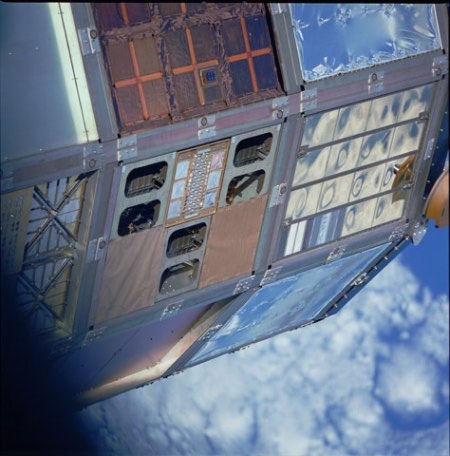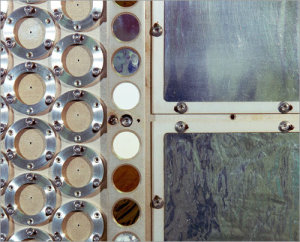When you’re thinking long-term, a period of 5.7 years seems like a mere blip in time. But NASA’s Long Duration Exposure Facility, deployed from the shuttle Challenger in 1984 and returned to Earth after 32,422 orbits, is a small-scale experiment that points to much weightier objectives. Think about the Voyager spacecraft, launched in 1977 and still operational after thirty-one years. Now ponder journeys to the heliopause and beyond, and potential missions to other stars that could last centuries. To learn how materials hold up in the space environment, we use tools like LDEF to collect data that can be gathered nowhere else.
57 experiments were mounted in 86 trays on the outside of the spacecraft, involving more than 200 principal investigators from private companies, universities, NASA centers, the Department of Defense and eight foreign countries. The idea was to study what happened to various materials when they were exposed to space, and as the Long Now Foundation’s Kevin Kelly noted earlier this year, each of the 86 panels has a certain ‘geeky modernist charm,’ the sort of look that wouldn’t be out of place at the trendiest modern art venues. Here you can see some of the panels on the LDEF spacecraft during the orbital experiment.

Indeed, writer and artist Jaime Morrison was so taken with these panels that he created an online gallery of them. For him, the LDEF spoke on many levels:
…it brings to mind the abstraction of certain painters, a gridded and measured minimalism in graphic design, failed utopian architecture, and the shapes and surface textures of every science fictional interior ever put on film. Add to that the subtle color palette peppered here and there with super saturated counterpoints, the unintentional, almost accidental, nature of its beauty, and (having been well battered during its 32,422 Earth orbits) the indelible stamp of decay…

And indeed, these LDEF panel shots are unforgettable in their own way. High technology as art is part of the human impulse, one that will surely accompany us on our way to the stars. The LDEF, along with the current Materials International Space Station Experiment (MISSE), is part of the enterprise of developing long-term solutions to problems, learning how to build structures that can experience space not for years or even decades but centuries. The distances involved in exploring the outer Solar System and beyond demand such thinking, not to mention the real possibility that we will one day choose to deploy large structures in space or on other worlds not just for research but lifelong habitation.
But there is another long-term issue that these panels speak to. Science itself proceeds through the efforts of researchers whose work contributes in ways small or large to the breakthroughs that actually make the news and change the course of civilizations. A breakthrough in interstellar propulsion would open possibilities we only dream about today, but if it comes, such a breakthrough may not appear for decades or centuries. The chastening demand of science is that without knowing the result, we continue to labor at the details, knowing that we may be playing only a small part in what could become an outcome that benefits all of humanity. Can the modern ego, fixated on quick gratification and immediate results, continue to adapt to what Tennyson called ‘the long result of time?’

Let’s hope and assume so. The danger of demanding quick fixes, as desirable as they may be, is that if they do not emerge, we may lose track of the ultimate goal, and of the fact that science is not about ego or personal success as much as it is about moving knowledge forward. Ad astra incrementis, the motto of the Tau Zero Foundation, reminds us that steps taken one by one must accumulate to produce the desired result, or as Lao-Tsu once said, “You accomplish the great task by a series of small acts.” And you do this without knowing whether you will see the outcome, or whether it will be reserved for your great-grandchildren or even, perhaps, theirs. In the grand scheme, what matters more than yourself is the goal.


Imagine that we had two experiments in which we had equipment or even frozen biologic material:
1) exposed to deep space and cosmic radiation over 43 years, and
2) exposed to the same amount and type of radiation but compressed into one year.
Would the wear and functionality of the two be approximately the same?
There have been visions of long-term interstellar missions with the realization that the craft would be exposed to radiation, micrometeorites, some heat, and time. As a result, self-repair with AI, wardens, and whatnot have been envisioned.
We could expose a craft to the same amount and type of environmental damage but in a much more compressed time frame. If outcomes would be anticipated to be approximately equivalent to the real thing, then we could develop and test equipment until it could survive the entire transit and we could forgo the need for AI and self-repair.
Paul, I seem to recall that you may co-published an article with an author whose specialty may be in this area (i.e. reliability). Perhaps he could give an opinion.
Hi Paul;
This study of exposing panels in space for several years is indeed important science although it is not of as high of public profile as say the Mars Probes landings or the LHC.
Since long duration manned interstellar missions are likely to take centuries, at least in terms of the first generation manned interstellar space craft, studies involving highly quantified data in the form of the measurements of interstellar gas, dust, and cosmic ray interaction with the out surfaces of manned interstellar space craft will prove highly important.
No amount of string theory, brame theory, supersymmetry, quantum gravity theories etc, that we might develope from observations using the LHC, numerical petaflops supercomputer methods and the like, will provide a quantitative description of the actual interstellar gas, dust particle, perhaps even pebbles, and cosmic rays, and potentially chemically reactive elements or ions, in terms of the reaction of such agents with the outer surface of the space craft, as well as with the space craft propulsion systems such as beam sails, solar and stellar sails, fusion ramjet engine components such as fusion fuel intake mechanisms etc.
The operation and safety of even very mildly relativistic manned interstellar space craft will require an in depth analyis using hard data of the interstellar medium or at the very least, from space based environments or from near Earth simulations of such.
The prospect of even very mildy relativistic manned interstellar flight might seem daunting, yet trivial compared to the vast distances to our stellar nieghboors, however, even the low interstellar transport velocity of say 0.005 C is more than capable of allowing us to outdo the escape velocity of any galaxy super-cluster, and so, permits in theory, unlimited distance of travel potential for our species. If we can learn how to live forever and survive forever as a species, than we can in theory travel infinite distances form our Milky Way home given all of physical eternity.
The study of these panels in space is just one important step in this unfolding process.
Thanks;
Jim
John Hunt writes:
John, you must be thinking of someone else — I haven’t worked with anyone on a paper on reliability issues, I’m afraid.
Hi Jim,
I think that this would be true for interstellar space craft with adult humans (living or suspended animation) in which death could result from failure. If, instead, our astronauts were frozen embryos (or primary gonadocyte tissue culture) then this problem becomes much less since we could afford a substantial failure rate.
I feel like somewhat of a broken record when it comes to frozen embryos but it just seems like it overcomes several major engineering and expense problems while addressing the existential threats which mankind seems to be facing within this century.
Hi John;
Thanks for the above concepts. Even though I like to think of humans traveling among the stars as adult persons, and hope we do some day,
I really like the frozen embryos (or primary gonadocyte tissue culture) concepts. I fact I seem to be enamored with the concept tonight.
Such biological entities could be encased in some form of diamond, perhaps diamond shells made from nanotech self assembly technology. When diamonds are preferentially created from an isotope which is not the predomenant one comprising natural diamonds, if I am not mistaken, the artficial diamonds have shown to have a greater hardness than the highest quality natural diamonds.
These diamond pods could be launched in droves at perhaps 0.01 C throughout the cosmos in all directions using mass drivers, really long mass drivers if reduced accelerational G forces are desired. Perhaps such mass drivers could be manufactured in interplanetary space, however, a mass driver capable of accellerating such a pod at a rate of 10 EXP 6 meters/(second EXP 2) for ~ 3 seconds would result in a velocity of 3 million meters/sec or 0.01 C. Using the (1/2)(a)(t EXP 2) Newtonian approximation, the launch tubes would be 4.5 million meters long or 4,500 kilometers long. This level of acceleration seems quite doable for advances in mass drivers since rifle bullets accelerating down the rifle barrel also experience, roughly, acceleration values of 10 EXP 6 meters/(second EXP 2): they reach 1 kilometer per second in about a millisecond.
The use of midrange mass blackholes that are rapidly rotating, might allow such small embryo pods to pass through the center of the toriodal ring like entity, or singularity, and enter a completely different universe, or perhaps a distant location within our universe in the past, present, or future.
The pods could have some form of conducting or superconducting shroud or housing in order to provide reactance to the mass drivers electrodynamic repulsive fields.
Thanks;
Jim